Saint Luigi Orione
புனித_லூகி_ஓரியன் (1872- 1940)
மார்ச் 12
இவர் (#StLuigiOrione) இத்தாலியைச் சார்ந்தவர்.
அருள்பணியாளராக வேண்டும் என்ற கனவோடு பிரான்சிஸ்கன் சபையில் சேர்ந்த இவருக்கு அங்கு உடல்நிலை சரியில்லாமல் போகவே வீட்டிற்குத் திருப்பினார்.
பின்னர் இவர் புனித ஜான் போஸ்கோவோடு தங்கியிருந்து கல்வி கற்றார். அவரது அடக்க நிகழ்வில் கலந்துகொண்டு வேண்டிக் கொண்டிருக்கும்போது இவருடைய நோய் நீங்கியது.
இதற்குப் பிறகு இவர் டோர்டோனா என்ற இடத்தில் இருந்த குரு மடத்தில் சேர்ந்து குருத்துவ வாழ்விற்குத் தன்னையே தயாரித்தார். இவர் குருத்துவப் படிப்புப் படித்துக் கொண்டிருந்தபோதே ஏழைக்காக ஓர் இல்லத்தைத் தொடங்கினார்.
1893 ஆம் ஆண்டு குருவாக அருள்பொழிவு செய்யப்பட்ட இவர் ஆண், பெண் என இருபாலருக்கும் துறவு அவைகளைத் தொடங்கினார். உரோமையில் ஓர் அனாதை இல்லத்தை நிறுவினார்; டோர்டோனாவில் மரியாவின் திருத்தலம் ஒன்றை நிறுவினார்.
இப்படி ஏழைகள்மீது மிகுந்த அன்பு இறைப்பணியைச் செய்த இவர் 1940 ஆம் ஆண்டு இதய நோய் காரணமாக இறையடி சேர்ந்தார். இவருக்குத் திருத்தந்தை இரண்டாம் ஜான்பால் 2004 ஆம் ஆண்டு புனிதர் பட்டம் கொடுத்தார்
Also known as
Aloysius Orione
Profile
Joined the Franciscans at Voghera, Italy as a young man, but developed severe health problems and returned to his family. Studied under Saint John Bosco at Turin, Italy, was present at Saint John's death, and was cured of his illness during Saint John's funeral.
Studied at the seminary in Tortona, Italy. While still a layman and student, he opened San Luigi House at San Bernardino in 1893, a home for the poor, homeless and abandoned. Ordained on 13 April 1895.
Founded the Hermits of Divine Providence congregation, the Ladies of Divine Providence, and an orphanage in Rome, Italy in 1899. Under the patronage of Pope Saint Pius X, he founded the Little Missionaries of Charity. Constructed the Marian shrine at Tortona, a site that became a rallying point for people during times of political unrest. To administer the houses of his congregations, Luigi travelled the world, visiting houses in Wales, Brazil, the United States, and throughout Italy.
Born
23 June 1872 at Pontecurone, Allessandria, Italy
Died
• 12 March 1940 at San Remo, Imperia, Italy from heart disease
• body found intact when exhumed in 1965
• interred at the shrine of Our Lady of Safe Keeping, Tortona, Italy
Canonized
16 May 2004 by Pope John Paul II
Martyrs of Nicomedia
Additional Memorial
28 December as part of the 20,000 Martyrs of Nicomedia
Profile
Eleven Christians who were martyred in succession in a single incident during the persecutions of Diocletian. First there were the eight imprisoned Christians, Domna, Esmaragdus, Eugene, Hilary, Mardonius, Maximus, Mígdonus and Peter, about whom we know little more than their names. Each day for eight days one of them would be strangled to death in view of the others so that they would spend the night in dread, not knowing if they were next.
Peter was the chamberlain or butler in the palace of Diocletian. When he was overheard complaining about this cruelty, he was exposed as a Christian, arrested, tortured and executed by having the flesh torn from his bones, salt and vinegar poured on the wounds, and then being roasted to death over a slow fire.
Gorgonio was an army officer and member of the staff in the house of emperor Diocletian; Doroteo was a staff clerk. They were each exposed as Christians when they were overhead objecting to the torture and murder of Peter. This led to their own arrest, torture and executions.
Died
in 303 in Nicomedia, Bithynia (in modern Turkey)
Blessed Giustina Bezzoli Francucci
Profile
Born to the nobility, Giustina grew up in a wealthy household. As a child, she frequently fasted on her own, and had a habit of hiding away to pray. She was drawn to the religious life, but her parents strongly opposed it, not wishing to lose their only daughter to the cloister. However, her father fell seriously ill, and during his recovery time he meditated on what was and was not important in life. This led him to give his blessing to Giustina becoming a nun.
She began her Benedictine novitiate at the monastery of San Marco at age 12; legend says that a dove landed on her as she walk into the convent, and all took this as a sign of blessing from the Holy Spirit on her choice. Feeling the need for more solitude, with her bishop‘s permission she became a hermitess and anchoress. She lived in isolation for 35 years; legend says that when wolves would gather around her hermitage, an angel would drive them off. In later years, her health began to fail, she became blindess, and she was forced to return to live in the convent. When the convent became unsafe due to civil unrest, she returned to her family home in 1315, and spent her remaining years there. Subject to ecstasies and received visions.
Born
c.1257 in Arezzo, Tuscany, Italy
Died
• 12 March 1319 in Arezzo, Tuscany, Italy of natural causes while praying
• a white lily grew out of the stone of her tomb
• body found incorrupt when moved in 1329
• body enshrined in an iron in the Holy Spirit Benedictine monastery in Arezzo
• body found incorrupt when moved in 1709
• relics enshrined in the Santa Maria del Flore Benedictine monastery in Lapo, Italy in 1968
Beatified
14 January 1891 by Pope Leo XIII (cultus confirmation)
Saint Joseph Zhang Dapeng
Also known as
• Iosephus Zhang Depeng
• Joseph Tchang Taong
• Joseph Tshang-ta-Pong
• Ruose
Additional Memorial
28 September as one of the Martyrs of China
Profile
A clever and inquisitive boy, he was much attracted to Taoism in his youth. He moved to Guiyang in 1794, and entered the silk business. Through a business contact, he first learned of Christianity. He converted, but was unable to join the Church because, in the custom of the day, he kept a concubine. He eventually left her, and in 1800, against strong opposition from his family and business associates, he joined the Church, taking the name Joseph.
Because of trouble at his business over his new-found faith, he went out on his own, opening his own store. He began a ministry of preaching and teaching, and converted a house into a small school for religion. He became a school principal in 1808, and worked as a catechist and altar server.
During the anti-Christian persecutions led by the White Lotus Cult, Joseph went briefly into hiding, but continued his catechist work covertly. In 1814 he was betrayed by his anti-Christian brother-in-law, and was arrested. He was lodged with Saint Peter Wu Gousheng, and the two spent their prison time ministering to other prisoners. He was offered his freedom if he would denounce Christianity; he declined. Martyr.
Born
c.1754 in Duyun, Guizhou Province, China
Died
• strangled to death on 12 March 1815 in Guiyang, Guizhou, China
• buried in Xijiaotang, China
• grass from his grave has become part of local folk remedies
Canonized
1 October 2000 by Pope John Paul II
Blessed Angela Salawa
அருளாளர் ஏஞ்சலா சலாவா
பொதுநிலைப் பெண்:
பிறப்பு: செப்டம்பர் 9, 1881
சியேப்ராவ், மலோபோல்ஸ்கீ, போலந்து
இறப்பு: மார்ச் 12, 1922 (வயது 40)
க்ரகோவ், மலோபோல்ஸ்கீ, போலந்து
ஏற்கும் சமயம்:
ரோமன் கத்தோலிக்க திருச்சபை
முக்திபேறு பட்டம்: ஆகஸ்ட் 13, 1991
திருத்தந்தை இரண்டாம் ஜான் பால்
பாதுகாவல்:
ஃபிரான்சிஸ்கன் துறவகங்கள்
மாணவர்கள்
சாவான நோய்களுக்கு ஆளான மக்கள்
மூளை மற்றும் முதுகு தண்டு நரம்பு செல்களில் ஏற்படும் நோயால் பாதிக்கப்பட்ட மக்கள்
அருளாளர் ஏஞ்சலா சலாவா (Blessed Angela Salawa) முதலாம் உலகப்போரின்போது மருத்துவமனைகளில் பணியாற்றிய ஒரு போலந்து நாட்டுப் பெண்மணியாவார். சார்புநிலையற்ற ஃபிரான்சிஸ்கன் சபையின் (Secular Franciscan Order) உறுப்பினரான இவர், மிகவும் பக்திவாய்ந்த குடும்பமொன்றில் பதினோராவது குழந்தையாகப் பிறந்தவர் ஆவார். முதலாம் உலகப்போரின்போது மருத்துவமனைகளில் நோயாளிகளினூடே பணியாற்றியதால், பின்னாளில் இவரும் நோய்த்தொற்று ஏற்பட்டு, தமது நாற்பது வயதிலேயே மரித்துப்போனார்.
"பர்ட்லோமியேஜ் சலாவா" (Bartłomiej Salawa) என்ற தந்தைக்கும் "ஈவா பொச்சேநெக்" (Ewa Bochenek) என்ற தாய்க்கும் பிறந்த பன்னிரண்டு குழந்தைகளில் பதினோராவது குழந்தையான ஏஞ்சலா, பிறந்த நான்காவது நாளில் திருமுழுக்கு பெற்றார். இவரது தந்தை ஒரு கொல்லன் ஆவார். மிகவும் ஏழ்மையான குடும்பம். இதன்காரணமாகவே ஆஞ்செலா இலகுவாக நோய்வாய்ப்படுபவராகவும் பலவீனமானவராகவும் இருந்தார். மிகவும் கீழ்படியும் குணமுள்ள இவர், தமது குடும்பத்திற்கு தம்மாலான உதவிகள் செய்துவந்தார். சிறு வயதிலேயே தாம் கிறிஸ்துவில் அழைக்கப்படுவதாக உணர்ந்தார்.
பதினாறு வயதிலேயே "க்ரகோவ்" (Kraków) நகரில் பணிப்பெண் பணி புரிவதற்காக வீட்டை விட்டு சென்றார். அங்கே, உலக நாட்டங்களில் ஈடுபாடு கொண்ட இவர், தமது சமய ஆர்வங்களிலிருந்து விலகிப்போனார். இவ்வுலக நாட்டங்களில் ஏற்பட்ட ஈடுபாடுகளை மறுபரிசீலனை செய்யும்படி கேட்டுக்கொண்ட தமது சகோதரி தெரெசா (Teresa) இறந்தபோது மிகவும் மனதளவில் பாதிக்கப்பட்டார்.
ஒருமுறை, திருமண வரவேற்பு நிகழ்ச்சியொன்றில் நடனமாடிக்கொண்டிருந்தார். அப்போது, இயேசு கிறிஸ்து தமதருகில் நிற்பது போலவும், "என்னைப் பின்தொடர விரும்பும் நீ இங்ஙனம் நடனம் போன்றவற்றில் நாட்டம் கொள்வதேன்" என்று கேட்பதாக உணர்ந்தார். மனம் வருந்திய ஏஞ்சலா, உடனே அங்கிருந்து விலகிச் சென்றார். தேவாலயம் ஒன்றிற்கு சென்று செபித்தார். நற்கருணை ஆண்டவரை வழிபட தொடங்கினார்.
சமயப் பணியாற்ற விரும்பிய ஏஞ்சலாவுக்கு அவரது பலவீன உடல்நிலை தடையாக இருந்தது. தூய்மை மற்றும் நல்லொழுக்கத்திற்காக தனிப்பட்ட முறையில் சத்திய பிரமாணம் எடுத்துக்கொண்ட இவர் 1912ம் ஆண்டு, "சார்புநிலையற்ற ஃபிரான்சிஸ்கன் சபையின்" (Secular Franciscan Order) உறுப்பினரானார்.
1914ம் ஆண்டு, முதலாம் உலகப்போர் வெடித்தபோது, அவர் மத இன வேறுபாடுகளின்றி காயமடைந்த போர் வீரர்களுக்கு சேவை புரிந்தார். ஏற்கனவே நோய்களால் பாதிக்கப்பட்டிருந்த ஏஞ்சலா, இன்னும் அதிகமாக பாதிக்கப்பட்டதை எவரும் கவனிக்கவில்லை. ஆனாலும் மனம் தளராது பணியாற்றினார்.
1916ம் ஆண்டு, இவர் மீது திருட்டுப் குற்றம் சாட்டிய இவரது முதலாளி, இவரை பணியிலிருந்து நீக்கினார். வீடற்ற ஏஞ்சலா, நோய்களின் தாக்கத்தால் வேதனைகளால் துயருற்றார். பார்க்க நலமடைந்த பெண்போல காட்சியளித்த காரணத்தால், மருத்துவமனையிலிருந்து வெளியே அனுப்பப்பட்டார். இறுதியில், குடும்பத்தால் கைவிடப்பட்டு, சொந்தங்களிழந்து, சுற்றத்தாரும் நண்பர்களும் இல்லாத அனாதையாக வாழ்ந்த ஏஞ்சலா, 1922ம் ஆண்டு, மார்ச் மாதம், 12ம் நாளன்று, மரணமடைந்தார்
Also known as
Aniela Salawa
Profile
Daughter of Salaw Bartlomiej and Ewa Bochenek, the youngest of ten children in a pious tradesman's family. She received two years of formal education, and at age 12 began work as a domestic in nearby homes. On 27 April 1900 she joined the Saint Zita Assocation, a religious group for maids. Within this church-centered place, Angela felt at home, and devoted her free time to the house, the church, and a call to religion, attending Mass daily and in routine contact with Franciscans. She was unable to enter religious life due to poor health, and continued to work as a maid and to mentor other young women. She became a Franciscan tertiary on 15 March 1912. Worked as a nurse in a Krakow hospital during World War I, spending her own money and any that she could beg to buy better food for injured soldiers. In 1917 her health collapsed completely; she spent the last five years of her life in a small room, surviving on the charity of the Saint Zita Association, and spending her time in prayer.
Born
9 September 1881 in Siepraw, Malopolskie, Poland
Died
• 12 March 1922 in Kraków, Malopolskie, Poland of natural causes
• relics transferred to the Franciscan Chapel of the Lord's Passion on 13 May 1949
Beatified
13 August 1991 by Pope John Paul II
Blessed Rutilio Grande García
Profile
The youngest of seven children born to a poor family, his parents divorced when Rutilio was small, and he was raised by his grandmother and an older brother. He began attending a high school seminary in San Salvador at age 12, and joined the Jesuits when he was 17. Ordained a priest on 30 July 1959.
Father Rutilio came into his own as a priest in the 1960’s; what he took from the work of Vatican II was that his own spiritual development would come from his self-sacrifice for the good of others. He became director of social action projects in San Salvador, and for nine years taught seminarians to live and work with the poor so that they were part of the flock, and to be an example of the church among them.
After work at the seminary, he became a parish priest and school teacher in Aguilares, El Salvador where he was murdered by El Salvadoran security forces while on his way to celebrate Saturday night Mass; he was the first priest martyred in the lead up to the civil war. A friend of Saint Oscar Romero, Saint Oscar later said the death of Blessed Rutilio was his own wake-up call to the cause of the Salvadoran people.
Born
5 July 1928 in El Paisnal, San Salvador, El Salvador
Died
• shot around 5pm on Saturday 12 March 1977 on the road between Aguilares and El Paisnal, San Salvador, El Salvador
• he was hit by 12 rounds
Beatified
22 January 2022 by Pope Francis
Saint Seraphina (Saint Fina or Saint Serafina)
புனிதர் ஃபீனா
கன்னியர்:
பிறப்பு: கி.பி. 1238
சான் கிமிக்னானோ, இத்தாலி
இறப்பு: மார்ச் 12, 1253
சான் கிமிக்னானோ, இத்தாலி
ஏற்கும் சமயம்:
ரோமன் கத்தோலிக்க திருச்சபை
பாதுகாவல்:
மாற்றுத் திறனாளிகள், நெசவாளர்கள்
நினைவுத் திருநாள்: மார்ச் 12
புனிதர் ஃபீனா அல்லது புனிதர் செரஃபினா (Saint Fina or Saint Serafina) ஓர் இத்தாலிய கிறிஸ்தவ குடும்பத்தில் பிறந்த சிறுமி ஆவார்.
“ஃபினா டே சியார்டி” (Fina dei Ciardi) எனும் இயற்பெயர் கொண்ட இவர், வட-மத்திய இத்தாலியின் “டுஸ்கனி” (Tuscany) மாகாணத்தின், “சியேனா” (Siena) பிராந்தியத்தின் “சேன் ஜிமிக்நானோ” (San Gimignano) எனும் மலை நகரில் 1238ம் ஆண்டு பிறந்தவர் ஆவார். இவரது பெற்றோர், "காம்பியோ சியார்டி" மற்றும் "இம்பீரியேரா" (Cambio Ciardi and Imperiera) ஆவர். ஒருவேளை உணவு கூட வயிறார உண்ணமுடியாத அளவிற்கு ஏழ்மையாக வாழ்ந்தவர். அவ்வாறு இருந்தபோதிலும், தன்னிடம் உள்ள உணவில் சிறிதளவை மற்ற ஏழைகளுடன் பகிர்ந்து வாழ்ந்தார்.
இவர், அதிதூய கன்னி மரியாளிடம் தீவிர பக்தியுள்ளவர். தமது வாழ்நாளில், திருப்பலிக்காக ஆலயத்திற்குச் செல்வதைத் தவிர்த்து வீட்டை விட்டு வெளியே சென்றறியாதவர். இவர் பிறரிடம் தீவிர அன்பு செலுத்துபவராக அறியப்படுகிறார்.
1248ம் ஆண்டு, ஃபீனா காசநோய் சம்பந்தப்பட்ட எலும்பு அல்லது எலும்பு மஜ்ஜையில் அழற்சி (Tuberculous Osteomyelitis) போன்ற பெரும் நோயால் தாக்கப்பட்டு, மிகக் கொடுமையான வேதனைகளை அனுபவித்தார். நோயின் வேதனை தாங்க முடியாமல் துடித்தபோதும், பொறுமையை இழக்காமல், இறைவனை இறுக பற்றி வாழ்ந்தார். படுக்கையை மறுத்து, மரக் கோரைப்பாயில் படுத்து உறங்கினார். தான் படும் வலிகளை இறைவனுக்காக அனுபவிக்கிறேன் என்று புன்னகையோடு ஏற்றார். இவரது இந்த ஆழ்ந்த தீவிர விசுவாசம் இவரது வேதனைகளைக் குறைத்தது.
நெடுநாளைய நோய்ப்படுக்கையால் இவரது உடல் இவர் படுத்திருந்த மரக் கோரைப்பாயுடன் ஒட்டிக்கொண்டதாக கூறுகின்றனர். இவரது உடலில் ஏற்பட்ட புண்களை புழுக்களும் எலிகளும் கடித்தனவாம். இவர் நோயில் இருக்கையிலேயே இவரது தந்தை மரித்துப்போனார். இவரது தாயாரும் பின்னர் கீழே விழுந்து மரணமடைந்தார். தமது துரதிர்ஷ்டத்திலும் ஏழ்மையிலும் இவர் இறைவனுக்கு நன்றி கூறிக்கொண்டேயிருந்தார். தமது ஆத்மா விரைவில் இவ்வுடலை விட்டு வெளியேறி இறைவனை காணவேண்டுமென்ற தமது விருப்பத்தை சொல்லிக்கொண்டேயிருந்தார்.
இப்புனிதரின் ஆழ்ந்த பக்தியானது, அவரை அடிக்கடி வந்து பார்த்துச் சென்ற சான் கிமிக்னானோ நகர மக்களுக்கு ஒரு சிறந்த எடுத்துக்காட்டாக அமைந்தது.
வாழும் போதே புனிதர் என்று போற்றப்பட்ட இவர், நோயுற்று, நீண்ட ஐந்து வருட வேதனையின் பிறகு, 1253ம் ஆண்டு, மார்ச் மாதம், நான்காம் நாளன்று, அவருடைய செவிலியர்களான “பெல்டியா” (Beldia) மற்றும் “பொனவென்சுரா” (Bonaventura) ஆகியோர் அவரது இறப்புக்காக காத்திருக்கையில், “புனிதர் பெரிய கிரகோரி” (Saint Gregory the Great) அவரது அறையில் தோன்றி, அவர் மார்ச் 12ம் தேதியன்று மரணமடைவார் என்று முன்னறிவித்தார். புனிதர் பெரிய கிரகோரி முன்னறிவித்தபடியே ஃபீனா மார்ச் 12ம் தேதி மரணமடைந்தார். அவர் இறக்கும்போது அவருக்கு வயது பதினைந்து.
இவரது இறப்பை முன்னறிவிக்க புனிதர் பெரிய கிரகோரி தோன்றியது, பெரும் அதிசயமாக ஏற்றுக்கொள்ளப்பட்டது.
இவர் “சேன் ஜிமிக்நானோ” (San Gimignano) நகரில் உள்ள பேராலயத்தில் அடக்கம் செய்யப்பட்டார். அப்பேராலயத்தின் அருகில் இவர் பெயரில் ஆலயம் ஒன்றும் கட்டப்பட்டுள்ளது
Born 1238
San Gimignano, Italy
Died 12 March [O.S. 5 March] 1253
San Gimignano, Italy
Venerated in San Gimignano, Italy
Feast March 12 and 1st Sunday of August
Attributes Violets, depicted with Saint Gregory the Great, or lying on her wooden board
Patronage disabled people, spinners
Also known as
Fina, Serafina
Profile
Born poor, and though she stayed that way, she still found ways to help those in worse shape that herself. A pretty girl, she lived as a hermit in her home, doing chores, giving to the poor when she could, spinning, sewing, and praying through the nights. Seraphina's father died when the girl was very young. Soon after, she was stricken with a condition that made any movement painful; she had to be carried everywhere on a board. Fina lived the rest of her life in constant suffering, and neglect, which she turned over to God in her constant prayers. She never joined an order but lived her life under Benedictine Rule. Devoted to Saint Gregory the Great who suffered from a condition like hers. She received a vision from Saint Gregory who foretold the date of her death.
Born
1238 at San Geminiano, Tuscany, Italy
Died
12 March 1253 of natural causes
Saint Paul Aurelian
Also known as
• Paul of Léon
• Paol Aorelian
• Paulinus Aurelianus
• Paul Aurelian of Léon
• Pol Aurelian
• Pol de Léon
Profile
Born a Romano-Briton prince, the son of Perphius, a Welsh chieftain. Educated at Llantwit Major with Saint David of Wales, Saint Samson of York, Saint Gildas the Wise and Saint Illtyd. Hermit. To escape being made a bishop, he and 12 companions established a monastery at Porz-Pol, Ouessant Island, Brittany (part of modern France. He later relented and became bishop of Ouismon. Spiritual director of his nephew, Saint Joavan of Brittany.
Legend says that Saint Pol subdued a dragon on the Île de Batz by wrapping his clerical stole around the animal's neck, then used his bishop‘s crozier to drag it to the north edge of the island and ordered it to disappeared into the sea.
Born
Glamorgan, Wales
Died
572 on Île de Batz, France
Saint Mura McFeredach
Also known as
• Murames McFeredach
• Muran McFeredach
• Murin of Fahan
• Mura of Fahan
Profile
Abbot of Fahan (Othan Mor), appointed by Saint Columba. Friend of King Hugh of Ireland. Spiritual teacher of Saint Laserian of Leighlin. Member of the O'Neill clan. Writer of a number of works including a rhymed biography of Saint Columba. In the ruined church of Saint Mura at Fahan is a beautiful Irish cross, and nearby is Saint Mura's Well.
Born
c.550 in County Donegal, Ireland
Died
• 645 of natural causes
• relics include his crozier at the National Museum, Dublin, Ireland, and his bell-shrine at the Wallace Collection, London, England
Saint Theophanes the Chronographer
Also known as
Theophanus the Confessor
Profile
Educated at the Byzantine imperial court. Married layman. Both he and his wife entered religious life. Founded two monasteries. Abbot at Mount Migniana abbey. Wrote a Chronography, a sort of abstract of history from 284 to 813. Arrested, tortured, and exiled to Samothrace by Leo the Armenian for opposing iconoclasm.
Born
Constantinople
Died
12 March 817 of natural causes
Saint Maximilian of Thebeste
Also known as
• Maximilian of Tebessa
• Maximilian of Theveste
• Mamilian...
Profile
Son of a Roman army veteran. Conscientious objector - when drafted into the Roman army, he refused to serve on the grounds that his faith prohibited it. Martyred for this stand.
Born
274
Died
• beheaded c.295 at Thebeste, Numidia, North Africa
• buried at Carthage
Blessed Girolamo da Recanati
Also known as
• Girolamo Gherarducci
• Jerome...
Profile
Priest. Member of the Hermits of Saint Augustine, and lived in their convent in Recanati, Italy. Worked as a peacemaker between warring Italian political and military factions.
Died
• 12 March 1350 in Recanati, Piceno, Italy of natural causes
• relics enshrined in the church of Sant'Agostino in Recananti
Beatified
1804 by Pope Pius VII (cultus confirmation)
Saint Bernard of Carinola
Also known as
Bernard of Capua
Profile
Studied at Monte Cassino Abbey; spiritual student of the abbot who later became Pope Victor III; fellow student of Saint Peter Damian. Priest. Counselor and chaplain to prince Jordan of Capua, Italy. Bishop of Forum Claudii, Italy, consecrated on 21 March 1087; he moved the see city to Carinola, Campania, Italy in 1100.
Born
1040 at Capua, Italy
Died
• 1109 of natural causes
• interred in a marble sarcophagus in the cathedral of Carinola, Italy
Blessed Manuel Solórzano
Profile
Lifelong layman in the archdiocese of San Salvador, El Salvador. He was married to Eleuteria Antonia Guillén, and the couple had ten children. In Aguilares, Chile, he sold seeds and cattle for a living. Murdered by El Salvadoran security forces while on his way to serve at Saturday night Mass. Martyr.
Born
c.1905 in Suchitoto, Cuscatlán, El Salvador
Died
shot around 5pm on Saturday 12 March 1977 on the road between Aguilares and El Paisnal, San Salvador, El Salvador
Beatified
22 January 2022 by Pope Francis
Blessed Beatrix of Engelport
Profile
Dominican nun in 1262 at the convent of Engelport in Hundsrück, Germany. All the nuns at the convent became Premonstratensians in 1272. Beatrix may have served as the first prioress.
Born
13th century Germany
Died
• c.1275
• interred in the choir loft of the convent church
• legend says that if the convent forgot to celebrate her feast day, Beatrix would make knocking noises in her tomb
• relics destroyed during the anti-Church excesses of the French Revolution
Blessed Nelson Rutilio Lemus Chávez
Profile
Young, single layman in the archdiocese of San Salvador, El Salvador. Murdered by El Salvadoran security forces while on his way to serve at Saturday night Mass. Martyr.
Born
10 November 1960 in El Paisnal, San Salvador, El Salvador
Died
shot around 5pm on Saturday 12 March 1977 on the road between Aguilares and El Paisnal, San Salvador, El Salvador
Beatified
22 January 2022 by Pope Francis
Saint Peter the Deacon
Also known as
Peter Levita
Profile
Benedictine monk, sub-deacon in Sicily, deacon in Rome. Friend, spiritual student and secretary to Pope Saint Gregory the Great; Gregory dictated four books of the Dialogues to Peter.
Born
6th century
Died
early c.605
Saint Alphege the Bald
Also known as
• Alphege of Winchester
• Alphege the Elder
• Ælfheah, Elphege, Elfego, Elpigio
Profile
Relative of Saint Dunstan of Canterbury and Saint Ethelwold. Monk. Bishop of Winchester, England in 935. Great supporter of the monastic life. Ordained Saint Dunstan and Saint Ethelwold.
Died
951 of natural causes
Saint Almut of Wetter
Also known as
Almud of Wetter
Profile
Born to the royal family. With her sister Digmund, she founded the convent of Wetter in Oberlahngau, Germany, and served as its first abbess.
Born
9th century Germany
Died
10th century
Saint Heiu of Hartlepool
Profile
First nun to take vows in Northumbria (part of modern England), consecrated by Saint Aiden of Lindisfarne. Founded a convent at Hartlepool, Northumbia, and later another at Healaugh, Northumbria.
Died
mid-7th century
Saint Fechno
Also known as
Fiachna
Profile
Spiritual student of Saint Columbanus. Went with Columbanus to evangelize in Scotland.
Born
northern Ireland
Died
• 580 of natural causes
• miracles reported at his tomb
Saint Corman of Iona
Also known as
Coman
Profile
Seventh-century priest. Monk at Iona Abbey. Missionary to Northumbria in northern England; he may have been the first priest to evangelize the area.
Born
Ireland
Saint Egdunus
Profile
Martyred in the persecutions of Diocletian with seven other Christians.
Died
hung by his feet over a fire to die of smoke inhalation in 303 in Nicomedia, Asia Minor
Saint Indrecht of Iona
Profile
Monk. Abbot of Iona Abbey. Martyred by Saxons while travelling to Rome, Italy.
Died
854
Blessed Claudius the Minor
Also known as
Claude
Profile
Franciscan monk.
Saint Basilissa of Asia
Profile
Married to a man named Felicius. Martyred, date unknown.
Symeon the New Theologian
Symeon the New Theologian (949–1022) was an Eastern Orthodox monk and poet, the last of three saints canonized by the Eastern Orthodox Church and given the title of "Theologian" (along with John the Apostle and Gregory of Nazianzus).
"Theologian" in this context doesn't refer to the modern academic sense of theological study; it was used to recognize someone who spoke from personal experience of the vision of God.
Symeon the New Theologian has two feast days depending on the tradition within the Eastern Orthodox Church:
March 12th: This is the anniversary of his death in 1022 and is the more widely celebrated feast day.
October 12th: This alternative feast day was established because March 12th often falls within the period of Great Lent, during which time celebratory feast days are typically not observed.

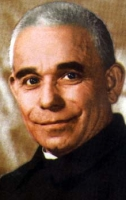


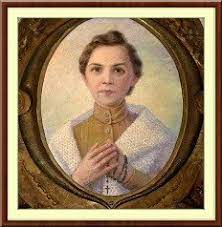

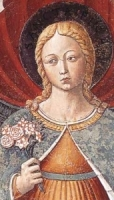




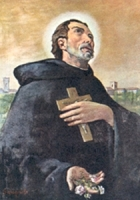
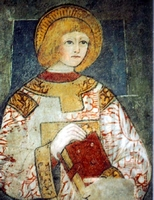

No comments:
Post a Comment